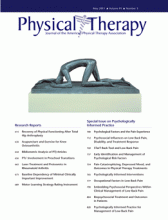Back pain remains a major health problem that poses significant challenges for clinical management.1 For example, epidemiological evidence suggests that only 20% to 40% of patients with low back pain who have received first-contact health care services no longer report pain or disability a year later.2 The back pain research community, therefore, is exploring ways to address this clinical management challenge in order to better reduce the long-term effects of back pain, such as persistent symptoms, low quality of life, and reduced capacity to work.
One idea that is receiving substantial attention in Europe is to reconfigure the model of health care provided to patients based on a stratified medicine approach. This approach, although gaining interest in other medical fields,3 has not yet been tested in back pain management. It involves the recognition that a “one-size-fits-all” approach to the management of nonspecific back pain,4 where groups of patients receive treatment irrespective of individual characteristics or prognosis, probably is suboptimal.5 This approach is impractical because it is impractical and inefficient to refer all patients with back problems for physical therapy due to the high numbers of patients and cost implications,6–9 despite evidence to suggest these treatments are more effective than …












